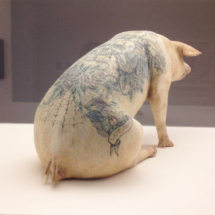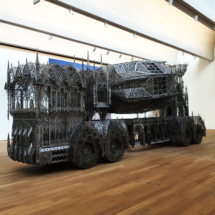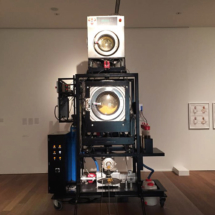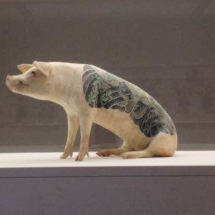by Viki Mladenovski
10 Years’ Anniversary Celebration
For its tenth anniversary, The Grand Duke Jean Museum of Modern Art, Mudam, in Luxembourg hosts an exhibition about the much praised contemporary artist Wim Delvoye. The show is curated by Enrico Lunghi and runs from the 2nd July 2016 until the 8th January 2017. Over two floors, visitors can admire Delvoye’s controversial work made over twenty-five years.
Born in 1965 in Wervik, Belgium, Wim Delvoye lives and works in Ghent but receives worldwide recognition for his diverse exhibitions. The neo-conceptual artist works with an extensive range of materials and the artworks he creates are all provocative in some way. He is best known for his Cloaka, a mechanic reproduction of our digestive system, which exists under different forms. One of those can be seen in the current exhibition at Mudam. The artwork vaguely resembles a washing machine due to the round window that exposes the yellowish liquid moving inside. Once a day, when the digestion is completed, the machine ejects its faeces. Delvoye keeps those end products in jars and eventually sells them. His machines, serving no real function at all, are the artist’s response to the purposelessness of life. Miniature replicas of his Cloaka, which comes with dolls reminiscent of Barbie dolls, can be purchased in the Mudam shop.
Other of his exhibited works are his stuffed tattooed pigs and a video of his project Art Farm, for which he took pigs from slaughterhouses and tattooed them. He started off with dead pigs, but quickly took it a step further by tattooing living animals. By tattooing the animals and filming them he gives them more personality and wants to raise their value from food to actors within an art performance. Nevertheless, even though he saved those pigs from being murdered he still exploits them for his own good and therefore receives a lot of negative critique.
Those are only two of his many works on display. His gothic sculptures, anal kisses, distorted crucifixes, and football goals with stained glass inspired by glass windows in Flanders are some of the other works which can be appreciated. The museum displays various sketches which the artist undertook for his final artworks. Those sketches give an insight in the artist’s talent as an illustrator and in his thought process, making the exhibition complete.

Delvoye has already collaborated with Mudam by creating Chapelle (2006) for the art museum, a work which is permanently exhibited. The stained glass of the metallic chapel is made out of X-Ray photographs with obscene motives like human insides and skeletons on them. This atheistic chapel combines beauty and ugliness, the scatological with the sacred, and is intended to change the way society perceives beauty. Wim Delvoye’s oxymorons serve to dissolve boundaries between mass culture and the elite as well as tradition.
Delvoye both succeeds in shocking and making the audiences laugh. This way, his artworks are refreshing and so is the scale of the variety of works. What makes Wim Delvoye’s art so special and worth seeing is that it aims to both mock the ridiculousness and seriousness of life.




